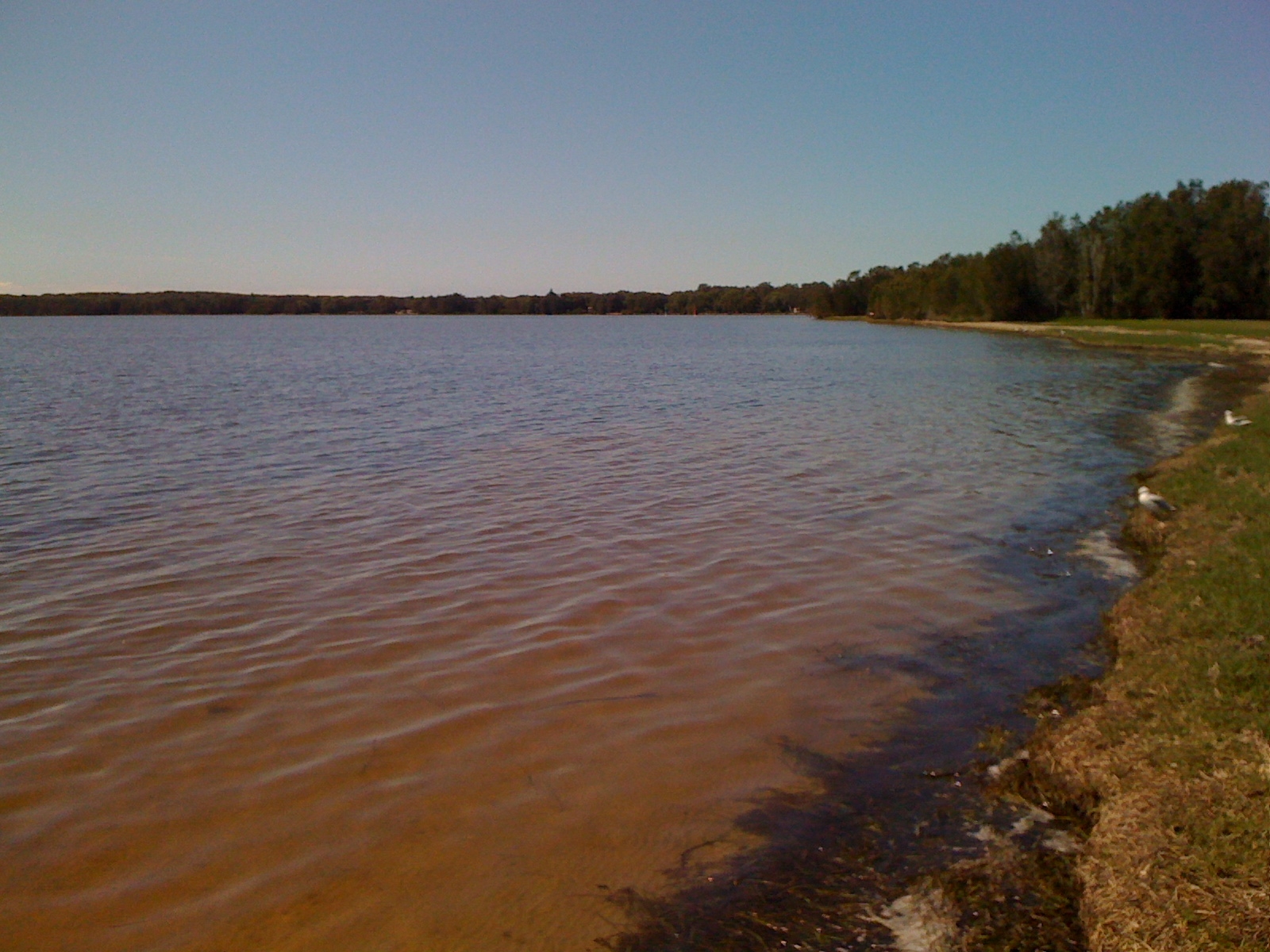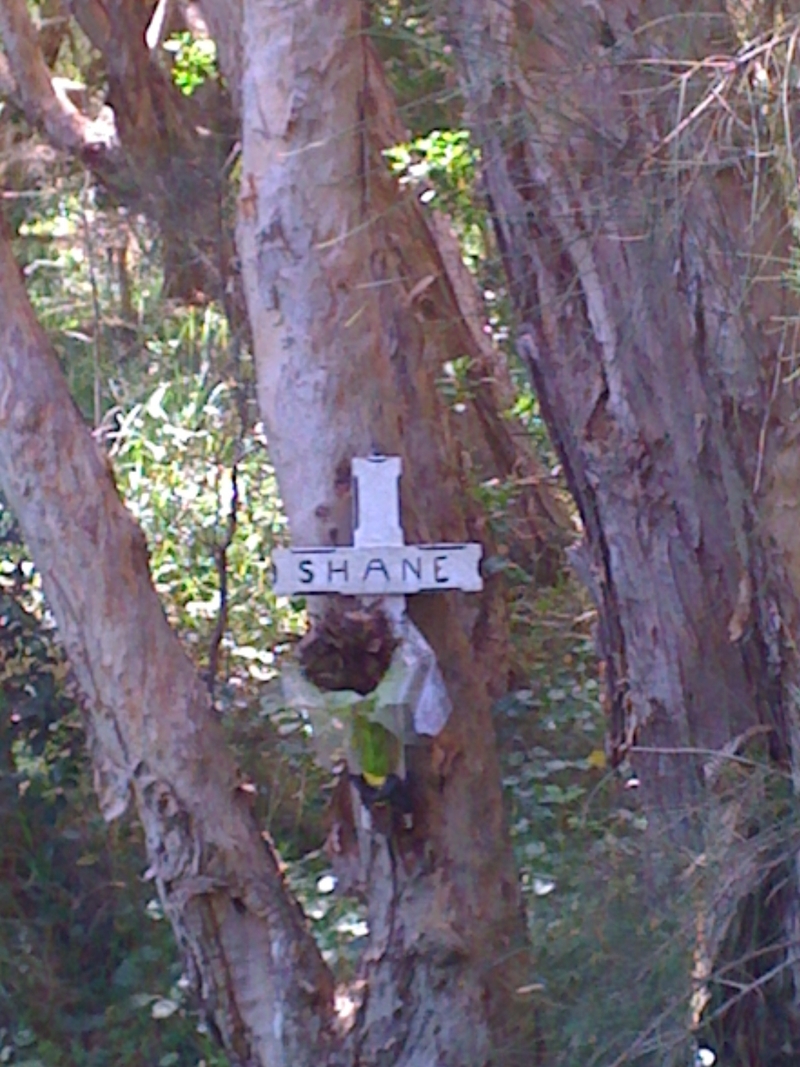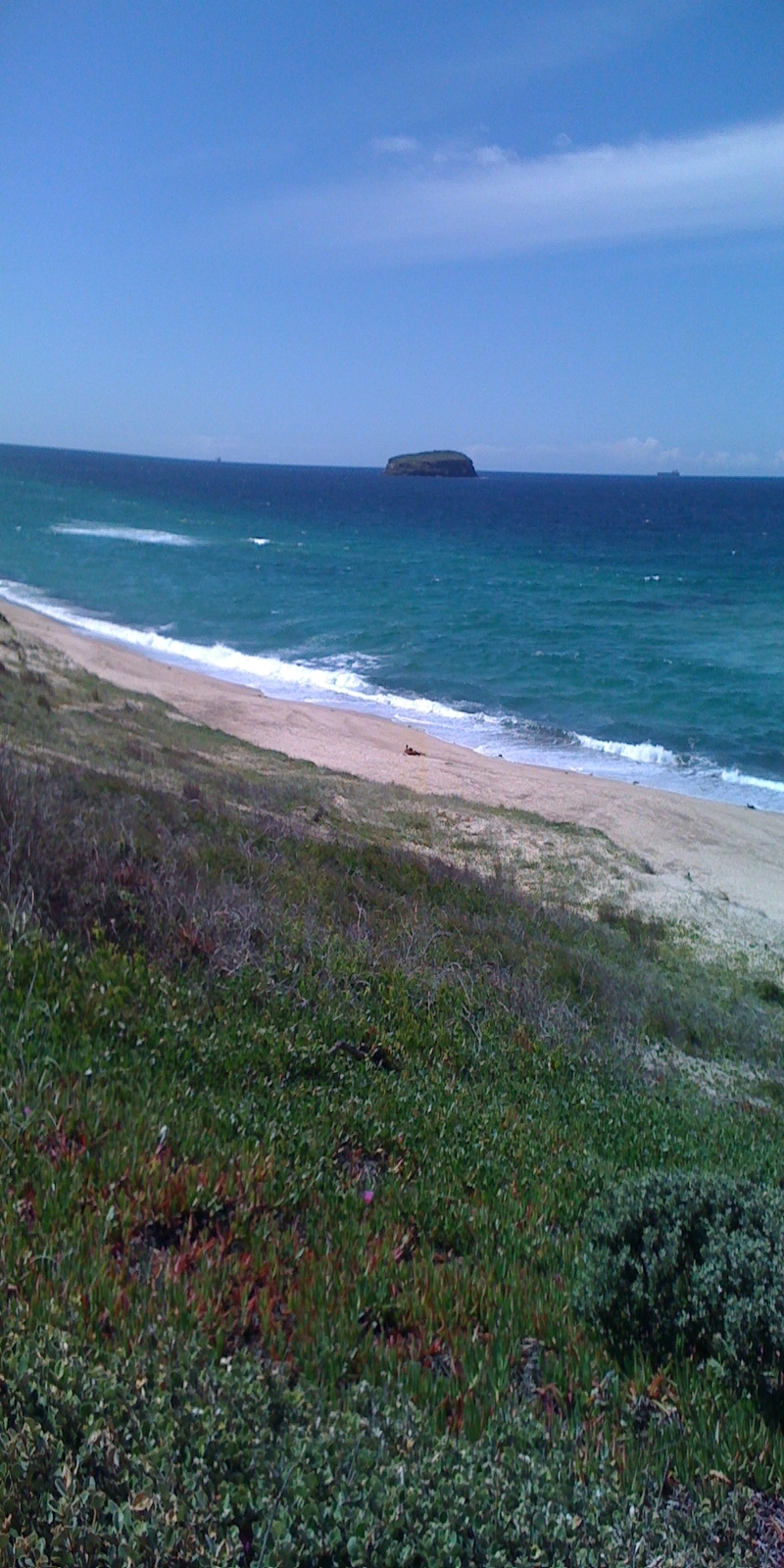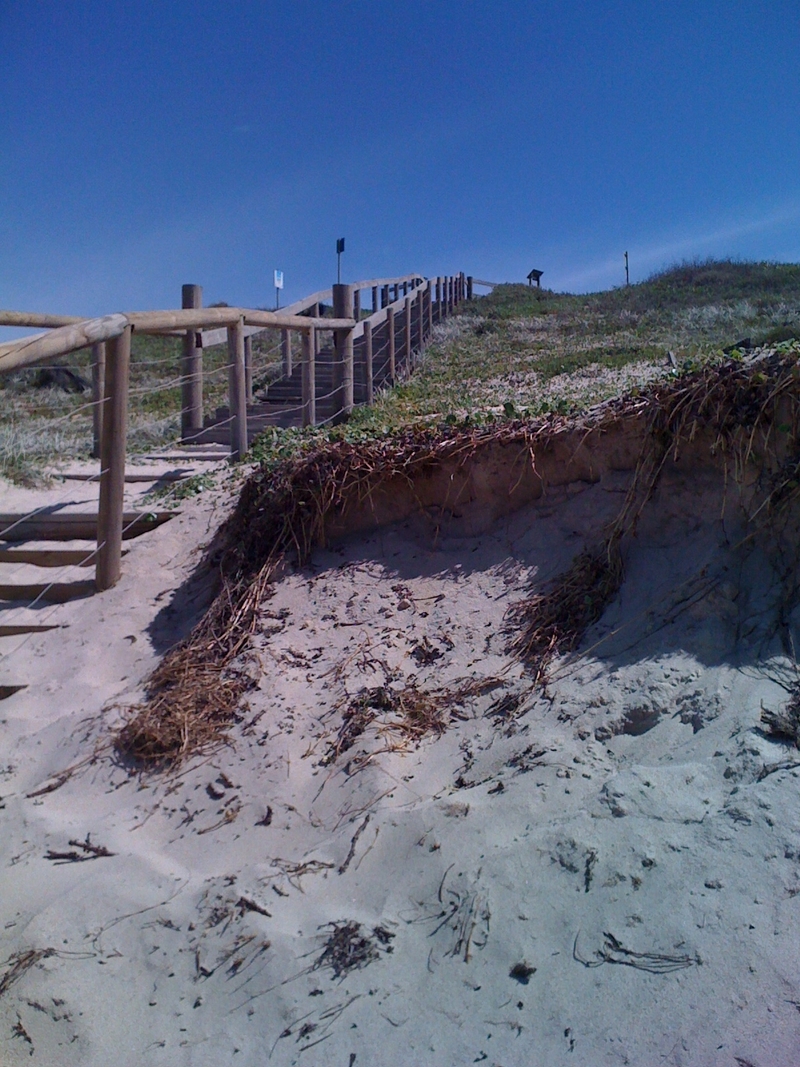Sick of hanging round the house, I rose early and rode Busways #90 (ticket: AUS$4.60) over to Budgewoi, on the opposite side of the lake. The cops were arresting some dude at the interchange at Lake Haven while I was waiting for my bus... typical. There was a big mob of single mums and truant teens congregated round the commotion, rubbernecking, teeheeing, bumming cigarettes... standard. It seemed like it was going to be a warm day, which is usual in this part of the world, at this time of the year. Once the bus pulled up, however, it was all air-con chilled and comfy, if somewhat claustrophobic. Pushing through the scrum, I climbed the step, paid the driver, and took my favorite seat behind the midriff exit, the one fronted with its own perspex shield. Maybe it is because it is shielded that I like it so much, it seems to offer some protection against something, I don't know what. I pulled out my iPhone and was checking the news when I noticed my old Salvation Army mate Simon stepping up on to the transport, so I gestured him over to sit with me. He obliged me cheerfully, the bus took off, and we were on our way through the dewy, sun-sparkled, spider silk-strewn streets. A little bit later, on the approach to Toukley Bridge, my drinking partner Steve boarded, and took a seat in front of me. I am not sure if he recognized me or not, but I certainly recognized him. I am starting to build up a network of Negroes up here in the Wyong Shire, 18 months after moving here, I am getting to know the scene pretty well. People wave to me when I walk the streets, they beep their horns as they drive past me. It makes me think I have been here too long, and that it is probably time to roll the dice again, and jump to a new locale. Do another Quantum Leap, and materialize into a brand new life. I have still got a year to go before the jump, but the coordinates are already being plotted, the warpdrive readied for action! Soon I will be on my merry way, winging myself to a whole different city/country/civilization, and Australia will be just a memory (again.) Anyway, I had a bit of a chat to Simon before he got off, and told him some yarns from my time in Japan in exchange for a bit of his life story. He seems like a drifter to me, a natural nomad: originally from Leichhardt in Sydney, he now works at the supermarket at Lake Haven, and is looking for a decent place to live in the vicinity. He complained about all the hoops you need to jump through to make it with the landlords these days, the character references required by real estate agents, the proof that you have a job, etc. Listening to Simon talk, I felt my resentment rise. Why do they make it so hard for nomads like us? I wondered. What's up with all this Nanny State nonsense? It's discrimination, that's what it is! discrimination against those who don't fit the regular profile! Discrimination, in other words, against people like me. Simon bundled out once we hit Toukley to attend his interview with the real estate agents, and Steve disembarked shortly afterwards. I was all on my own in my fave seat as the bus lumbered on, through the backstreets of Norahville, taking me on a nostalgia trip of my early adulthood (I used to work at the newspaper here in 1994/95). Ahead of me, blonde-haired women were sharing tips on how to rort the Housing Department, while their blonde kids ran amok up and down the aisle. It is a very blond(e) blue-eyed part of the world here, and kind of a fascistic one... a welfare fascist state, if such a thing is possible. A whole lost tribe of Britons grown up feral among the gum trees and rainbow lorikeets, DNA bleached by the relentless sun. Flotsam and jetsam of a vanished Empire, washed up on to the Antipodean shore. Quite a few people up here are on the dole, myself included. Public transport in Australia seems reserved for folks like us. This is not Japan, where CEOs are humble enough to catch the train to work. Here in Oz humility is not a virtue anymore, and the CEOs probably get around town by helicopter. We turned on to Budgewoi Road and motored along past holiday homes, caravan parks, and even the odd golf course. Fibro shacks presently yielded on the right to a long, scrub-lined beach. This was Lakes Beach, in fact, and my mission for the day was to follow it homeward, back to Norah Head, where Wallarah Road would pick me up and carry me through Toukley to the Wallarah Bay Recreation Club. Where hopefully my Dad and a couple of beers were waiting! While in the area I also wanted to have a peek at Lake Munmorah, which the satellite pics claim is up here. I like to get a mental map of the geography, wherever I am living; I like to know my way around on foot, just in case I get lost and can't find my way back home.
 |
| Lake Munmorah, looking north and somewhat east, towards Newcastle (Australia, 2013) |
The satellites were right... Lake Munmorah was up here, and I found it easily enough, near the sleepy retail heart of Budgewoi. The lake was smaller than I imagined, and its shores less developed than its companions up here, such as my mistress (Budgewoi Lake). Seaweed padded the bank like a rotting carpet, encasing within in it fallen tree trunks and pieces of driftwood washed up from God only knows where, the occasional strewn bottle of beer or crumpled aluminum can, packed full of mud. The coastal plain from Tuggerah to Newcastle is riddled with lakes like this one, perforated with them, and I have often wondered how they formed. My Mum reckons they all started as bays: the western foreshores of the lakes were once beaches on the open sea, augmented by headlands and river mouths, and all the other usual Australian coastal features. Over time the bays clogged up with run-off from the rivers, and sand bars surfaced offshore, eventually linking up to create shallow lagoons within their perimeter. Having colonized the sea, land was in turn colonized by life, and the sand bars were overlaid with spear grasses, shrubs, trees, possibly even a littoral rainforest or two. Animals moved in to consume the plants or those animals which fed on them: birds, marsupials, fruit bats, frogs. Invasions washed over the region like high tides on a sandy beach, like tsunami. Four waves of human conquest followed, the last of them the Anglo-Saxon wave, settlers lured by the promise of prawns and outdoor sports, cheap housing just a few hours from the suburban sprawl of Sydney. That's the whitefella history of this region, the local Darkinyung Aboriginal people doubtless have their own creation story. Since the whitefellas won, their version became history. And so it will remain, until the whitefella settlement is itself submerged, and thrown back to the bottom of the sea. I'd say it will happen sometime before 2200, courtesy of Global Warming! Thus we have been warned; thus we will be warmed.
From the lake it wasn't that far to Lakes Beach, through an arm of somnolent suburbia. I strode past Halekulani Bowling Club with its attendant courtesy buses, crossed the channel which connects Lake Munmorah and Budgewoi Lake. Budgewoi actually means "meeting of the two waters" in the local Aboriginal language, and I wouldn't be surprised if the name sprang from this very channel, the one I was lucky to cross today. I continued over the Central Coast Highway, its asphalt surface burning hot in the sun. Waves could be heard crashing reassuringly not too distant, and there was a soothing salt smell in the air. I looked forward to being able to walk along the beach, and feel warm, soft sand between my toes. But the ocean also provokes in me a fear which is close to primal, so I was a little apprehensive about getting close to it. When I walk along the coast it feels like I am literally on the edge of the Earth, and I worry about falling off. Kind of irrational, but that is how it feels. Perhaps it is a symptom of agoraphobia.
 |
| Michael's Walk floats across this meadow, on the Budgewoi Beach Circuit (Australia, 2013) |
One thing I noticed during a previous trek up here is how dramatically the vegetation changes the closer you get to the sea, plant leaves growing waxy, forests giving way to heaths and meadows where grevilleas flower in their sclerophyllus pods, and tiny blue wrens flit between the grasses, twitching like cicadas. Many people might think that the Australian landscape looks the same wherever you go but once you get to know it, and let go of your preconceptions, you will see that it actually comprises a cacophony of tiny habitats, each with their own inhabitants, noisy miners for the open spaces for example, more mysterious birds for the thicker bush. There are kingdoms built on top of kingdoms on top of kingdoms, realms on top of realms on top of realms. If you know how to read it, there is a story to be learnt here. In a burst of creativity Divinity beget the elemental realm from which emerged, from Sheer Nothing, the stars and planets, the galaxies and black holes, time and space itself. Stars burnt for billions of years, then burst into fiery supernovas, generating the heavy elements in their death throes. On rocky worlds orbiting second generation stars such as our own these elements aggregated, giving birth to the mineral kingdom, sandy beaches and mountains, volcanoes and tectonic plates, wide oceans shimmering beneath their local suns. Amazing enough, but greater glories were to come, on the planets lucky enough to be in the right place, with all the right conditions (the Goldilocks Zone): from the dexterity of carbon molecules began to order themselves, spontaneously, into life. Thus arose the vegetable kingdom, the animal kingdom, the fiefdom of the fungi... and finally the most audacious creation of all, the House of Humanity, Self-Awareness manifested directly into flesh...
As I traversed the sand drifts and scrub which bordered the ocean, I realized that the hot sun was making me thirsty. I looked out wistfully for a vending machine, but I knew I would never find one, not out here. I was on the edge of civilization, the interface of the cultivated world and the primeval nature from which it sprang. Even if there was a vending machine out here, it probably wouldn't work. This was not Japan, where green tea reprieves await you at every bend in the road, even way out in the wilds, near the summit of Mt Fuji. No, this was not Japan at all. I cut through the scrub, where volunteers had toiled to restore natural vegetation to the Pacific shore, and located some kind of path. The path (named Michael's Walk) led me to a boardwalk which floated over a patch of dry swamp. At the end of the boardwalk I found a sign describing the dune restoration project, dedicated lovingly to the memory of Julie Luff, a local resident and dunecarer.
 |
| In memory of Julie Luff, a map of the Budgewoi Beach Circuit Walk (Australia, 2013) |
Just a few steps on, the ocean now in sight, I was stopped in my tracks by a crucifix hanging from a paperbark tree. The crucifix was emblazoned with the mysterious name, "Shane", and accompanied by a bouquet of wilted flowers. I stood mesmerized before this makeshift shrine for a moment or two, wondering who Shane was, and what had happened to him here. Was it an accident, suicide, or death by drowning? His spirit might well still be hanging around here, haunting this sun-scorched coast.
Michael's Walk, the dedication to Julie Luff, and now Shane's tree, I thought. It seems like every square inch of land here is named after someone!
 |
| Memorial to a guy named Shane (Australia, 2013) |
Everyone tries to leave their stamp on things, something to signify that they had been here. Dogs piss on trees, and monarchs brand their heads on to their stamps and coins. Patting the bulge in my pocket as I made my way down to the beach, I pondered: Why are the coins so heavy in Australia, so clunky, so chunky? I would like living here more if the coins were more practical. A pedantic thought, perhaps, but I believe there is symbolism in everything, even especially in the currency, in the currency that a country chooses to use. What does the Australian 50 cent coin tell you about this country, anyway: that we are clumsy people, that we're ruled by a foreign Queen? The huge coins are like the huge pills the pharmacists expect you swallow... they are not user-friendly. Not like the pills or the coins in Japan.
 |
| Bird Island, off the Lakes Beach, in Wyong Shire, NSW (Australia, 2013) |
I took off my thongs and tumbled down to the beach, ready to commence my long walk to Norah Head. My eyes running along the shore, I tried to imagine what it would like flying over this coast in a passenger jet, headlands falling away beneath me, sandstone glinting in the sun, coal ships queued up on the approach to Newcastle, that great port to the near north. A jolt of electricity passed down my frame, adrenaline squirting up my arms, towards my hands. It was too much to think about, even to simulate it. My phobia was too strong. Mild despair gripped me, and a sinking feeling... when was I ever going to get off this rock? I remembered a month or so earlier, during an anxiety attack, I had been afraid to even look at the stars in the night sky, due to the overpowering sense of dread they engendered. To gaze upon the face of that naked immensity, that colossal emptiness, is truly a frightening thing... an entire Universe twinkling in the sky above, all those stars and floating worlds, stretching away remotely, but yet bearing their presence forcefully upon yours. That's the thing living in Australia, you see a lot of stars at night. You are dreadfully exposed. Beneath our feet, things are no less comforting. What really goes on down there, anyway?
 |
| Tumbling down the stairs on to the warm sands of Lakes Beach, near Budgewoi (Australia, 2013) |
Sometimes these days it feels as if I am living in a floating world, cast adrift on a rising tide. The ground beneath my feet seems solid enough, but I know that the whole continent is riding like a raft on a magma sea, creeping north, irrepressibly. Above me the sky, that infernally cheerful blue sky... what could be more steadfast than that sky you might think, what could be more dependable? But like the ground, the blue sky is a deception, a lie... you could even call it a mirage. The sun is not yellow at all, it is white, and the blueness of the sky is merely an effect, caused by the scattering of the solar radiation through the atmosphere. As Einstein boldly proclaimed, we are all trapped in our own little bubbles of relativity only rarely encountering all the other floating bubbles out there, like ships passing in the night. Rare is the man or woman intuitive enough to notice when the bubbles bounce against each other in a momentary collision, soft film walls yielding ever so slightly. Rarer still is the man or woman who can pierce the film which separates our floating worlds in a resounding pop!, and dive through the mirror from one universe into another, merging with it, breathing underwater.
















